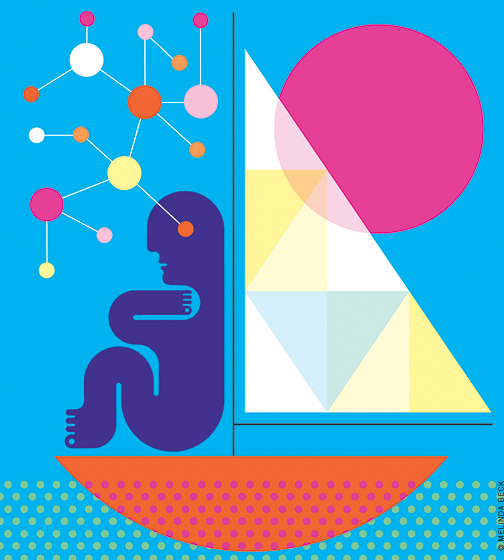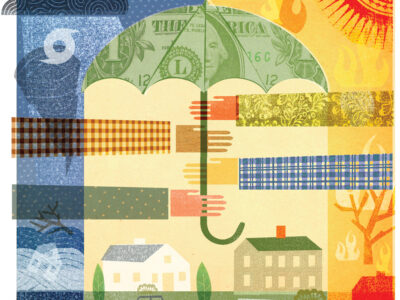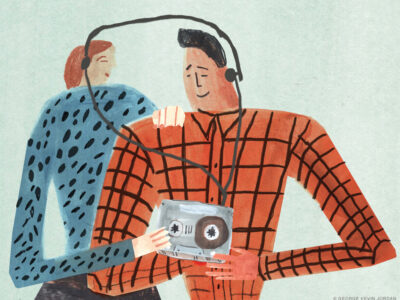
How sailing fueled Britton Chance’s amazing scientific career.
By Alex Soojung-Kim Pang | When I was a first-year graduate student writing about Louis Kahn’s groundbreaking Richards Medical Research Building, one of my advisors told me, “You really need to talk to Britton Chance.”
Chance Ch’35 Gr’40 Hon’85, who had met Kahn during the planning stages and worked in the building for more than 20 years, was a particularly vocal admirer. (People seemed to either love Kahn’s vision or hate the building’s impracticality, I discovered.) “Besides,” my advisor added, “he’s quite a character.”
A few weeks later, I went to the Eldridge Reeves Johnson Foundation for Medical Physics, which Chance directed from 1949 to 1983. He didn’t disappoint. He was in his seventies, but still published dozens of papers a year, advised students, and was able to keep several conversations on completely different topics going at once. And as if that weren’t enough, he was also a world-class sailor who had won a gold medal in the 1952 Helsinki Olympics.
I was impressed and intimidated. I had trouble finishing my weekly reading and doing the laundry, much less excelling in two completely different fields. I didn’t have the nerve to ask how he managed to do so much, or how his lives as a scientist and sailor might have built on each other. Years later, though, when working on my latest book, Rest: Why You Get More Done When You Work Less, I discovered that Chance’s dual life was far from unique. His life still seems extraordinary, but not quite as mysterious, and it offers some lessons that even a young graduate student could absorb.
Britton Chance spent most of his life at Penn. Born in 1913, he grew up in Wilkes-Barre and Haverford, Pennsylvania, received a BA in chemistry from Penn in 1935, and a PhD in physical chemistry in 1940. He spent World War II at MIT working on radar systems (and completed a second PhD at Cambridge University in 1942). After the war and a Guggenheim postdoctoral fellowship in Stockholm, Chance returned to Philadelphia, and was soon promoted to full professor and director of the Johnson Foundation. Over his 70-year career, Chance would publish nearly 2,000 papers, receive 200 patents, make fundamental contributions to the study of the role of enzymes in metabolic functions, the biochemistry of mitochondria, electron tunneling in biological systems, magnetic resonance imaging, and medical photonics (his main research focus at the time of his death in 2010 at age 97).
This was the Chance I saw as a graduate student: a phenomenally productive workaholic who stayed at the top of his game thanks to endless hours in the laboratory. For most of his career, students and family recalled, he would spend 12-hour days in the Johnson Foundation, adjusting instruments, conducting experiments, and supervising a tight-knit group of graduate students and postdocs.
Most Fridays, though, he would lead his family and a rotating cast of graduate students and visiting scientists to his house in Mantoloking, New Jersey, a small town on Barnegat Bay a couple hours east of Philadelphia. For the next couple days, science would give way to sailing. During the racing season he was an avid competitor—as well as a keen ham radio operator—and his home was stocked with as many as a dozen craft, from small duckboats to custom-made racing yachts. (Chance’s father than been a successful industrialist.) He had a gift for choosing academic conferences near the water—traveling to the Baltic, Mediterranean, and Caribbean.
To most scientists and academics today, spending months each year on the water—or even longer, as Chance did when preparing for the 1952 Olympics—would seem an extravagant distraction from the critical career-building activities of teaching, research, and hustling for money. Even in Chance’s day, science was a highly competitive enterprise, and early-career scientists needed to work fast and make their mark before their skills became obsolete or someone else beat them to a discovery. Chance knew this; in fact, his career had been put on hold during World War II, when he shifted from biological research to radar development, and he spent the years immediately after the war catching up to his peers. Yet Chance kept returning to the water. Why?
The answer is that for Britton Chance, science and sailing weren’t competitors. They were partners. And as I discovered while writing Rest, a surprising number of very successful scientists, writers, and others find that the right kind of break from work helps stimulate and sustain their creativity and productiveness.
When you look at the daily lives of previous generations of creative pioneers, you see a counterintuitive pattern. Even though they were ambitious, impatient to succeed, and could be obsessive about their work, many also engaged in what I call “deep play” (a term popularized by cultural anthropologist Clifford Geertz). Whether they became avid gardeners, athletes, painters, or musicians, the most successful and long-lived creative figures all chose hobbies that followed a common pattern. They had some strong family or historical component. They were mentally absorbing, and often physically challenging. Finally, they offered some of the same satisfactions as their professional work, but at a different time scale or in a different medium.
For example, X-ray crystallographer Rosalind Franklin, whose measurements of DNA were used by James Watson and Francis Crick to establish its double helix structure, was introduced to mountain-climbing by her parents, and as an adult she became a fearless, enthusiastic mountaineer. Climbing required similar sorts of problem-solving skills and observational abilities as laboratory work, but in an environment that was often intensely strenuous. Satisfaction came after a single day on the mountain, in contrast to the months it could take to complete an experiment.
Winston Churchill was an avid painter, a hobby he described in his short book Painting as a Pastime. Both painting and statecraft, he explained, required a clear vision, careful planning, and decisive execution; but dabbing paint against canvas in the outdoors was “great fun.” And the Labour Party never complained that his clouds were too small. In other words, he found similar challenges and satisfactions in both, but painting allowed him to experience them in a different context, on his own terms, and without the frustrations of political life.
Unlike more passive entertainments, or mere diversions or distractions, deep play doesn’t compete with work. Because it is psychologically restorative, and offers a mental break from even the toughest problems, deep play enables people to work even more intensely. Sailing was Britton Chance’s deep play.
First, it was a family affair. His father, Colonel Edwin Chance, was a wealthy Philadelphia industrialist, inventor, and avid yachtsman. When Britton was a teen, the Chance family sailed to the Caribbean on the 105-foot ketch Antares. At 13, Britton received a commercial radio operator’s license; four years later he invented an automatic ship-steering mechanism (the sale of which funded his graduate studies). His 11 children and stepchildren all sailed; some eventually became competitive sailors themselves, and one became a well-known naval architect.
Sailing also required some of the same skills Chance used in the lab. Designing scientific instruments and troubleshooting ham radio units both drew on his deep knowledge of electronics. His favorite boat, the 5.5-meter yacht, was a “formula class,” which meant that competitors could outfit their boats with a variety of hull designs, rigging, and weighting. This allowed for endless experimentation and tinkering, and Chance outfitted his yacht depending on local conditions. (Not all his experiments worked: racing officials quickly outlawed a device he invented that injected drag-reducing chemicals in the water in front of the bow.)
But even though he recognized the similarities and was often accompanied by students or postdocs, Chance treated sailing as a respite from science. In the laboratory, Chance said, “You never reach a decision without having all possible information at hand.” But on the water, it’s often necessary to make decisions based on instinct.
Long periods on the water functioned like sabbaticals, providing time for new ideas to germinate and plans to form. A 1938 voyage from England to Australia to test his automatic steering mechanism became a period “of remarkable intellectual challenge for me, providing time for clear thinking about the problem of rapid reactions,” which culminated in the stop-flow apparatus, the first of many scientific instruments he would invent. Even taking time off to train for the 1952 Olympics, in a period when he was still rebuilding his career, “helped invigorate my research,” he later said. “Having conquered the waters, I was ready for an even bigger challenge, tackling the great unknowns of biochemistry.” When he returned to Penn in the fall of 1952, he started a new program in mitochondrial biochemistry that would lead to some of his most important work.
Appreciating the role of deep play in creative lives can help us craft better lives ourselves. Overwork has morphed from a seasonal phenomenon or sign of bad planning into a status symbol: as one recent academic study concluded, “having no life is the new aspirational lifestyle.” We assume that science, other creative work, or indeed any high-powered career requires exclusive round-the-clock attention, and the sacrifice of other pursuits. But people who have long, productive creative lives show that this is false. Deep play sustains their appetite for serious work and provides resilience in the face of uncertainty and setbacks. Pursuing activities like mountain climbing or sailing forces them to organize their time, to avoid small distractions, and to compartmentalize and concentrate on one thing at a time. In today’s always-on, multitasking world, it’s more important than ever that we have activities that help us stay focused, stimulate our creativity, and sustain long, creative lives.
Alex Soojung-Kim Pang C’86 G’88 Gr’91 is the author of Rest: Why You Get More Done When You Work Less (Basic Books, 2016).




